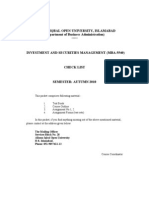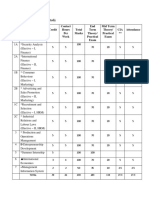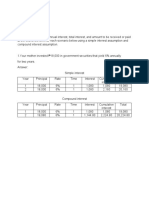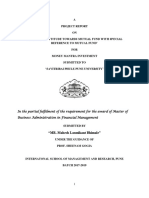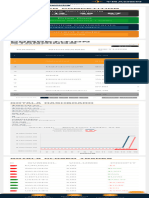Investment Analysis Hand Book - NUML-Final
Investment Analysis Hand Book - NUML-Final
Uploaded by
kamran47126Copyright:
Available Formats
Investment Analysis Hand Book - NUML-Final
Investment Analysis Hand Book - NUML-Final
Uploaded by
kamran47126Original Description:
Original Title
Copyright
Available Formats
Share this document
Did you find this document useful?
Is this content inappropriate?
Copyright:
Available Formats
Investment Analysis Hand Book - NUML-Final
Investment Analysis Hand Book - NUML-Final
Uploaded by
kamran47126Copyright:
Available Formats
Department of Economics NUML, Islamabad
Investment Analysis and Portfolio Management
COURSE OUTLINE
Course: Investment Analysis and Portfolio Management
Course Code: ECFN-302
Credit Hours: 3
Program: BS Economics & Finance/Economics (6th Semester)
Instructor: Dr. Nosheen (dr.nosheen@numl.edu.pk)
COURSE DESCRIPTION:
This course is intended to introduce the concepts and tools of security analysis and portfolio management. The course
content covers market structure and trade execution, client characteristics and their effect on portfolio construction,
the asset allocation decisions, the security allocation decisions by considering the risk and return, market efficiency
and trading strategies. In addition, selected topics related to portfolio risk management and portfolio performance
evaluation will be discussed. Course is prepared keeping in view the continuous rapid changes in the securities
markets in terms of theory, new financial instruments, innovative trading practices, and the fallout from the
significant credit and liquidity disruption and the numerous regulatory changes that followed.
COURSE OBJECTIVES:
The objective of the course is:
1. To study theory and empirical evidence relevant for portfolio management.
2. To understand how an investment professional would allocate funds in a hypothetical portfolio.
3. To estimate capital market parameters, trade-off between risk and return, optimal portfolio selection, equilibrium
asset pricing models, and delegated portfolio management.
4. To put emphasis on development of techniques that should be part of the tool kit of those interested in becoming
professional investors.
COURSE LEARNING OUTCOMES (CLOs):
On successful completion of this course, students will be able to:
CLO1: Understand investment analysis and portfolio management principles and theories.
CLO2: Apply quantitative techniques for investment opportunity analysis.
Handbook (fall 2023-fall 2024)
Department of Economics NUML, Islamabad
CLO3 Evaluate investment instruments and strategies.
CLO4 Construct and manage investment portfolios.
CLO5 Assess and manage investment risk.
CLO6 Understand ethical and professional considerations in investment analysis. Use and explain the underlying
principles, terminology, methods, techniques and conventions used in the subject.
TEACHING METHODOLOGY:
1. Three hours of lectures per week
2. In-class activities (quizzes, presentations, discussions, in class activities etc.,)
3. Written assignments and projects.
RECOMMENDED TEXT AND REFERENCE MATERIAL:
Required Text:
“Investment Analysis and Portfolio Management” by Frank K. Reilly and Keith C. Brown.
Recommended:
Investment (5th E) by Robert C. Radcliffe.
Investments Analysis and management (10th Ed) by Charles P. Jones.
COURSE EVALUATION/ASSESSMENT SYSTEM:
End term Exams 50% Duration: 03 Hours 50
Midterm Exams: 30 % Duration: 02 Hours 30
Internal Evaluation: a) Quizzes (5-10%) 20
20% b) Assignments: (5-10%)
c) Project/Presentation/Technical Report (5-10%)
d) Before Midterm Exams: 2 Quizzes – 2 Assignments.
e) After Midterm Exams: 1 Quiz –1 Assignments – 1 Project
presentation
Total Marks 100
Handbook (fall 2023-fall 2024)
Department of Economics NUML, Islamabad
WEEK WISE SYLLABUS WITH THEIR CONTRIBUTION TO CLOs:
Assessment
Lecture Scheduled Topic CLO
Activity
01 The Investment Setting
The Investment Setting
CLO 1
Revisions of Finance basics
What is an investment?
02 The Investment Setting
CLO 1
Investments: background and issues
Measuring risk and return
Measures of historical/expected rates of
return
03 Risk measures for historical/expected returns CLO 5
Standard Deviation
Variance Coefficient of Variation
04 Determinants of required rates of return
Nominal and real risk free rate CLO 5
Risk premium
Risk Premium and portfolio theory
05 Relationship between Risk and Return
SML line CLO 5
Changes in the SML line
06 The Asset Allocation Decisions
Individual Investor Lifecycle Assignment 1 CLO 1,2
The Portfolio Management Process
Quiz 1
The need for Policy Statement
Input to the Policy Statement
07 The Asset Allocation Decisions
The importance of asset allocation CLO 1,2
Objectives and Constraints of Institutional
Investors
08 Setting investment in a Global Market
The case for global investments CLO 1
Global Investment Choices
Fixed-Income Investments
Equity Investments
09 Special Equity Instruments
Options CLO 3
Futures Contracts
Historical Risk and Return on Alternative
Investments
Handbook (fall 2023-fall 2024)
Department of Economics NUML, Islamabad
10 Organization and Functioning of Securities Markets CLO 3
What is Market?
11 Types of Markets
Money Vs Capital Markets
Primary Vs Capital Markets CLO 3
Debt Vs Equity Markets
Regional exchanges and the over-the-
counter market
12 Types of Markets
Detailed Analysis of Exchange Markets Assignment 2 CLO 2
How Securities are traded
Types of Orders
Changes in the Securities Markets
13 Security Market Indicator Series
Uses of Security Market Indexes CLO 2
Differentiating Factors in Constructing Market
Indexes
14 Stock Market Indicator Series
➢ Value-Weighted Series CLO 3
➢ Price-Weighted Series
➢ Un-weighted or Equal-Weighted Series
15 Bonds Market Indicator Series Quiz 2
➢ Investment Grade Bonds CLO 3
➢ Junk Bonds
➢ Annual security risk-returns and correlations
➢ Comparison of Indexes Over Time
16 Efficient Capital Markets
Why should capital markets be efficient? CLO 3
Alternative efficient market hypotheses
Implications of efficient capital markets
17 Tests and results of efficient market hypotheses
Weak form hypothesis: Tests and results CLO 2
Semi-strong form hypothesis: Tests and results
Strong form hypothesis: Tests and results
18 An Introduction to Portfolio Management CLO 4
Background assumptions
Markowitz portfolio theory
19 Introduction to Portfolio Management CLO 4
Measuring risk and return
Expected return for individual investment
20 Introduction to Portfolio Management
Expected return for a portfolio Assignment 3 CLO 4
Variance and standard deviation of return for an
individual investment
21 Investor Utility
More than two assets portfolio and estimation
issues
CLO 4
The efficient frontier
The efficient frontier and investor utility
Handbook (fall 2023-fall 2024)
Department of Economics NUML, Islamabad
22 An Introduction to Asset Pricing Model CLO 3
Capital market theory: An overview
Risk-free asset
23 An Introduction to Asset Pricing Model
Market portfolio Quiz 3 CLO 3
The Capital Asset Pricing Model: Expected
return and risk
24 Relaxing the assumptions of CAPM
Differentiating borrowing and lending rates CLO 5
Transaction costs
Heterogeneous expectations and planning periods
Taxes
25 Multifactor models of risk & Return CLO 5
The market portfolio: theory versus practice
26 Multifactor models of risk & Return
CLO 5
APT and its Uses Project
Other Multi factor Models
27 Evaluation of Portfolio Performance
CLO 6
Significance of Evaluation of Portfolios
28 Evaluation of Portfolio Performance
Sharpe’s Measure CLO 6
Treynor’s Measure
Jensen Alpha
Handbook (fall 2023-fall 2024)
You might also like
- SecuritizationDocument122 pagesSecuritizationarchanaNo ratings yet
- OTHM - PGD A & F - Assignment Brief - Investment AnalysisDocument3 pagesOTHM - PGD A & F - Assignment Brief - Investment AnalysisIsurika PereraNo ratings yet
- FIN504 - Equity ResearchDocument15 pagesFIN504 - Equity Researchsurbhi guptaNo ratings yet
- PGDM-FM Corporate Finance CODocument6 pagesPGDM-FM Corporate Finance COdapper011No ratings yet
- Fin401, Corporate Finance PDFDocument3 pagesFin401, Corporate Finance PDFKRZ. Arpon Root HackerNo ratings yet
- IBA - Syllabus - Financial Management Summer Semester 2022Document5 pagesIBA - Syllabus - Financial Management Summer Semester 2022susheel kumarNo ratings yet
- Security Analysis and Port Folio Management: Question Bank (5years) 2 MarksDocument7 pagesSecurity Analysis and Port Folio Management: Question Bank (5years) 2 MarksVignesh Narayanan100% (1)
- Business ValuationsDocument5 pagesBusiness ValuationsCarrots TopNo ratings yet
- Course Outline - Portfolio ManagementDocument10 pagesCourse Outline - Portfolio ManagementSubhasish RoutNo ratings yet
- FIN 401-FM Course Outline-NAmin-Fall2022Document5 pagesFIN 401-FM Course Outline-NAmin-Fall2022Hafsah AnwarNo ratings yet
- Course Outline of MBA 04125204 - Financial ManagementDocument10 pagesCourse Outline of MBA 04125204 - Financial Managementiqbal.naser30No ratings yet
- Allama Iqbal Open University, Islamabad (Department of Business Administration)Document7 pagesAllama Iqbal Open University, Islamabad (Department of Business Administration)sajid bhattiNo ratings yet
- FIN 301: Financial Institutions and Markets School of Business Studies, IBA KarachiDocument5 pagesFIN 301: Financial Institutions and Markets School of Business Studies, IBA Karachimknightblaze139No ratings yet
- FIN301 - Financial ManagementDocument8 pagesFIN301 - Financial ManagementSHANILA AHMED KHANNo ratings yet
- Course Outline Investment Banking - BKFSDocument6 pagesCourse Outline Investment Banking - BKFSAman MehtaNo ratings yet
- Fund Management For Financial Institutions BNKG-4306Document3 pagesFund Management For Financial Institutions BNKG-4306TanvirHamidNo ratings yet
- Investment Analysis and Portfolio Management: Pre-Requisite: None Course ObjectivesDocument3 pagesInvestment Analysis and Portfolio Management: Pre-Requisite: None Course ObjectivesAmit SrivastavaNo ratings yet
- Sullabus FMI MBM Spring 24Document3 pagesSullabus FMI MBM Spring 24bibornomohin1987No ratings yet
- FMI Course OutlineDocument9 pagesFMI Course OutlineGhulam HaiderNo ratings yet
- PAM Outlines 07012021 042154pmDocument7 pagesPAM Outlines 07012021 042154pmzainabNo ratings yet
- THREE-5540-Investment and Securities ManagementDocument7 pagesTHREE-5540-Investment and Securities ManagementNabeel IftikharNo ratings yet
- Financial Management - Syllabus - ACBSBDocument8 pagesFinancial Management - Syllabus - ACBSBThùy Dung PhạmNo ratings yet
- IAPMDocument7 pagesIAPMrossNo ratings yet
- Syllabus PFS3363Document3 pagesSyllabus PFS3363SriSaraswathyNo ratings yet
- Course Outlines Business EconomicsDocument7 pagesCourse Outlines Business Economicsl237300No ratings yet
- Invest Instruments 06-07 HandbookDocument6 pagesInvest Instruments 06-07 Handbookratul_011No ratings yet
- Course Outline-FMDocument5 pagesCourse Outline-FMSadequl ShahinNo ratings yet
- IAPM BMS Semester V and VI Syllabus To Be Implememnted 2018 2019Document2 pagesIAPM BMS Semester V and VI Syllabus To Be Implememnted 2018 2019Sagar Talreja IprNo ratings yet
- TYBMS Syllabus 08022021 AC ApprovedDocument131 pagesTYBMS Syllabus 08022021 AC ApprovedBenji JamesNo ratings yet
- FIM301 - Financial Institutions and MarketsDocument5 pagesFIM301 - Financial Institutions and MarketsAshar ZiaNo ratings yet
- Air University Islamabad Department of Business AdministrationDocument7 pagesAir University Islamabad Department of Business AdministrationHamzaNo ratings yet
- Security Analysis and Portfolio ManagementDocument4 pagesSecurity Analysis and Portfolio ManagementSrinita MishraNo ratings yet
- Iapm Course Outline UpdatedDocument2 pagesIapm Course Outline UpdatedKumar PrashantNo ratings yet
- ECON0 IntroductionDocument14 pagesECON0 Introductionphu.nguyenthienNo ratings yet
- Fixed Income Secu DebtDocument4 pagesFixed Income Secu DebtDivyanshu ShekharNo ratings yet
- Bba Sem V Final SyllabusDocument23 pagesBba Sem V Final SyllabusSagarNo ratings yet
- Course Outline MicroeconomicsDocument3 pagesCourse Outline Microeconomicsmfarazkhan650No ratings yet
- Syllabus Student BWFN3013Document3 pagesSyllabus Student BWFN3013Dik Rei ChooNo ratings yet
- Investment Analysis and Portfolio AnalysisDocument3 pagesInvestment Analysis and Portfolio Analysissonu602sonuNo ratings yet
- 144E2ADocument2 pages144E2Asafeekmohammed385No ratings yet
- GFF6333 - BFN3144 Financial DerivativesDocument10 pagesGFF6333 - BFN3144 Financial DerivativesAndrewLimNo ratings yet
- Screenshot 2024-10-25 at 10.33.26Document62 pagesScreenshot 2024-10-25 at 10.33.26seoualkh29No ratings yet
- Module_Security Analysis and Portfolio ManagementDocument3 pagesModule_Security Analysis and Portfolio ManagementAashitaNo ratings yet
- SIFD - Dr. SabithaDocument15 pagesSIFD - Dr. SabithaSampath SanguNo ratings yet
- 3rd Sem SyllabusDocument32 pages3rd Sem SyllabusRohit ManeNo ratings yet
- MBA 1.5 Outlines PDFDocument148 pagesMBA 1.5 Outlines PDFMaQsud AhMad SaNdhuNo ratings yet
- Advanced Financial ManagementDocument5 pagesAdvanced Financial Managementaksharmohta17No ratings yet
- Syllabus 2016 ADV ACCT IIDocument6 pagesSyllabus 2016 ADV ACCT IIKristina KittyNo ratings yet
- Dipfa Qualification SpecificationDocument10 pagesDipfa Qualification SpecificationstellaNo ratings yet
- asset_allocation_in_investment_printableDocument26 pagesasset_allocation_in_investment_printableLaurenNo ratings yet
- r02 Investment Principles and Risk Examination SyllabusDocument3 pagesr02 Investment Principles and Risk Examination SyllabusDesty Cristya AnisaNo ratings yet
- Syllabus OldDocument165 pagesSyllabus Oldumesh1374No ratings yet
- Investment and Project Appraisal: Product: 4311 - Course Code: c227Document34 pagesInvestment and Project Appraisal: Product: 4311 - Course Code: c227MARWWANo ratings yet
- CMFAS CM EIP Study Guide (6 June 2024) (Final)Document442 pagesCMFAS CM EIP Study Guide (6 June 2024) (Final)angelinayuenciNo ratings yet
- LPU TextBookDocument352 pagesLPU TextBookkosoca2677No ratings yet
- Deloitte Uk Fs Banking Clo StructuresDocument16 pagesDeloitte Uk Fs Banking Clo StructuresWooyeon ChoNo ratings yet
- Investment and Portfolio ManagementDocument8 pagesInvestment and Portfolio ManagementnurallesaceNo ratings yet
- BBA SYLLABUS Sem-5 18-21Document24 pagesBBA SYLLABUS Sem-5 18-21SagarNo ratings yet
- Capital Structure and Corporate Financing Decisions: Theory, Evidence, and PracticeFrom EverandCapital Structure and Corporate Financing Decisions: Theory, Evidence, and PracticeRating: 5 out of 5 stars5/5 (1)
- Achieving Investment Excellence: A Practical Guide for Trustees of Pension Funds, Endowments and FoundationsFrom EverandAchieving Investment Excellence: A Practical Guide for Trustees of Pension Funds, Endowments and FoundationsNo ratings yet
- Simple InterestDocument3 pagesSimple Interestjohn gabriel bondoyNo ratings yet
- Summer Internship ProjectDocument55 pagesSummer Internship ProjectMahesh BhimaleNo ratings yet
- Xauusd Cheat SheetDocument2 pagesXauusd Cheat Sheetdeshrijit100% (1)
- Accounting For CorporationsDocument6 pagesAccounting For Corporationsmaine pamintuanNo ratings yet
- Allergan PLC.: Price, Consensus & SurpriseDocument1 pageAllergan PLC.: Price, Consensus & Surprisederek_2010No ratings yet
- Sales and Marketing at Hindustan Unilever: International Journal For Multidisciplinary ResearchDocument9 pagesSales and Marketing at Hindustan Unilever: International Journal For Multidisciplinary ResearchVinayak TiwariNo ratings yet
- Competition Leaderboard TFT 2Document1 pageCompetition Leaderboard TFT 2Samy Ï Kabwe NundaNo ratings yet
- Advanced-Strategic-Management Solved MCQs (Set-8) McqMate - Com-2Document8 pagesAdvanced-Strategic-Management Solved MCQs (Set-8) McqMate - Com-2arthurquamenaNo ratings yet
- Securities Regulations Code and Related LawsDocument5 pagesSecurities Regulations Code and Related LawsRoji Belizar HernandezNo ratings yet
- Session 6.4-Bootstrapping LectureDocument4 pagesSession 6.4-Bootstrapping LectureQamber AliNo ratings yet
- PMSGD Sep2022Document292 pagesPMSGD Sep2022YASH CHAUDHARYNo ratings yet
- (Anatoly B. Schmidt) Quantitative Finance For PhysicistsDocument3 pages(Anatoly B. Schmidt) Quantitative Finance For PhysicistsManiNo ratings yet
- App 05Document152 pagesApp 05KaziTanvirAhmedNo ratings yet
- Financial Sector Presentation AnchalDocument20 pagesFinancial Sector Presentation AnchalPrashant Kumar100% (2)
- Distribution To ShareholdersDocument47 pagesDistribution To ShareholdersVanny NaragasNo ratings yet
- Debt Policy at Ust IncDocument18 pagesDebt Policy at Ust Incapi-371968794% (16)
- Lecture 1Document39 pagesLecture 1hussam.khanNo ratings yet
- Investment and Portfolio Management Session 3 SolutionsDocument3 pagesInvestment and Portfolio Management Session 3 Solutions李佳南No ratings yet
- CHAPTER 7 UpdatedDocument21 pagesCHAPTER 7 UpdatedPhương KhanhNo ratings yet
- Angel Broking Questionnaire by GokulDocument5 pagesAngel Broking Questionnaire by GokulRagav AnNo ratings yet
- Pertemuan 12 - MODUL AKUNTANSI KEUANGAN - CH 12 - CORPORATION - Dividend and Retained EarningsDocument6 pagesPertemuan 12 - MODUL AKUNTANSI KEUANGAN - CH 12 - CORPORATION - Dividend and Retained EarningsLenrik AbcNo ratings yet
- John Hussman Wine Country Conference 2014 VeryMeanReversionDocument36 pagesJohn Hussman Wine Country Conference 2014 VeryMeanReversionJames J Abodeely100% (1)
- Edelweiss Equity Savings FundDocument3 pagesEdelweiss Equity Savings Fundfinis76054No ratings yet
- Werabe UniversityDocument32 pagesWerabe UniversityabatmaryeNo ratings yet
- 20 Pip ChallangeDocument1 page20 Pip Challangevinitvvv043No ratings yet
- Finance Question BankDocument10 pagesFinance Question BankSameer WableNo ratings yet
- Gmail - Proposed Initial Public Offering of The Equity Shares of Ujjivan Small Finance Bank LimitedDocument4 pagesGmail - Proposed Initial Public Offering of The Equity Shares of Ujjivan Small Finance Bank LimitedManish BarnwalNo ratings yet
- WWW - Pocketful.in: About Pocketful ( - Under Construction)Document3 pagesWWW - Pocketful.in: About Pocketful ( - Under Construction)Korra Akshitha KeerthiNo ratings yet
- SEC OCZ Notes From FBNDocument8 pagesSEC OCZ Notes From FBNBob HannahNo ratings yet
- Nimblr TA: Technical Analysis Daily True Range (DTR) & Low Margin Cash TradingDocument4 pagesNimblr TA: Technical Analysis Daily True Range (DTR) & Low Margin Cash TradingHarsh LullaNo ratings yet




















